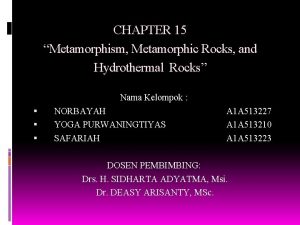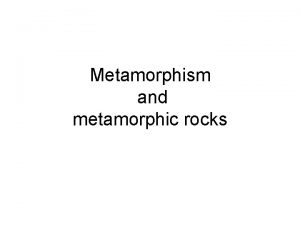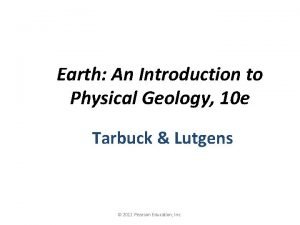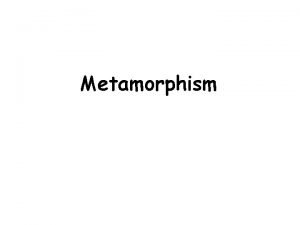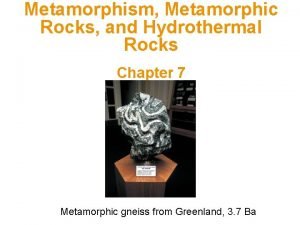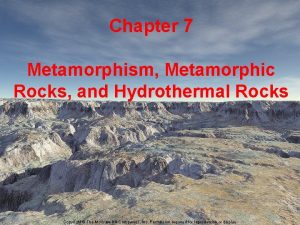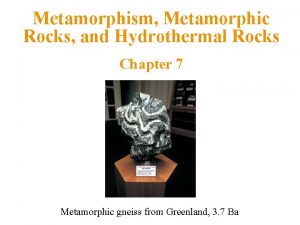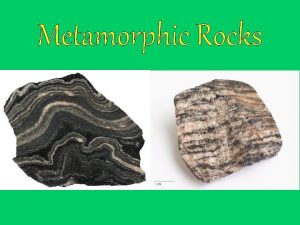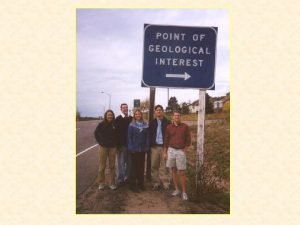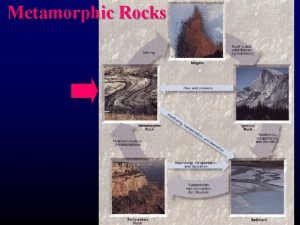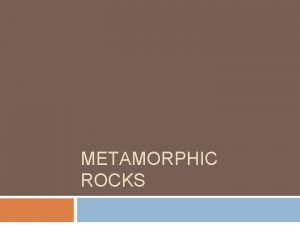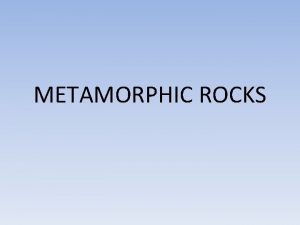Metamorphism Metamorphic Rocks and Hydrothermal Rocks Chapter 7











- Slides: 11

Metamorphism, Metamorphic Rocks, and Hydrothermal Rocks Chapter 7 1

7. 1 Metamorphic Rocks • Metamorphism refers to solid-state changes to rocks in Earth’s interior – Produced by increased heat, pressure, or the action of hot, reactive fluids • Rocks produced from pre-existing or parent rocks in this way are called metamorphic rocks 2

Factors Controlling Metamorphic Rock Characteristics • Texture and mineral content of metamorphic rocks depend on: – – Parent rock composition Temperature and pressure during metamorphism Effects of tectonic forces Effects of fluids, such as water • Parent rock composition – Usually no new elements (other than water) are added to rocks during metamorphism – Resulting metamorphic rock must have very similar elemental composition to that of parent rock 3

Factors Controlling Metamorphic Rock Characteristics • Temperature during metamorphism – Heat for metamorphism comes primarily from outward flow from Earth’s deep interior – All minerals stable over finite temperature range – If temperature gets high enough, melting will occur • Pressure during metamorphism – Confining pressure is pressure applied equally in all directions – High-pressure minerals have more compact structure/higher density 4

Factors Controlling Metamorphic Rock Characteristics • Tectonic forces – Often lead to forces that are not equal in all directions (differential stress) – Compressive stress causes flattening perpendicular to stress – Shearing causes flattening by sliding parallel to stress – Planar rock texture of aligned minerals produced by differential stress is known as foliation • Foliation increases with pressure and time 5

Factors Controlling Metamorphic Rock Characteristics • Fluids – Hot water (as vapor) is most important – Rising temperature causes water to be released from unstable minerals – Hot water very reactive; acts as rapid transport agent for mobile ions • Time – Metamorphism, particularly from high pressures, may take millions of years – Longer times allow newly stable minerals to grow larger and increase foliation 6

7. 2 Metamorphic Rock Classification • Classification based on rock texture – Foliated (layered) vs. non-foliated (non-layered) – Foliated rocks named based on type of foliation (slaty, schistose, gneissic) – Non-foliated rocks named based on composition • Time – Metamorphism, particularly from high pressures, may take millions of years – Longer times allow newly stable minerals to grow larger and increase rock foliation 7

Types of Metamorphism • Contact metamorphism – High temperature is dominant factor – Produces non-foliated rocks – Occurs adjacent to magma bodies intruding cooler country rock – Occurs in narrow zone (~1 -100 m wide) known as contact aureole – Rocks may be fine- (e. g. , hornfels) or coarse-grained (e. g. , marble, quartzite) 8

Types of Metamorphism • Regional metamorphism – – – High pressure is dominant factor Results in rocks with foliated textures Prevalent in intensely deformed mountain ranges May occur over wide temperature range Higher pressure and temperature will produce increased metamorphic grade – Prograde metamorphism of shale produces: • slate • phyllite • schist • gneiss 9

7. 3 Plate Tectonics and Metamorphism • Regional metamorphism associated with convergent plate boundaries – Pressure generally proportional to depth – Temperature at given depth varies laterally at convergent boundaries • Isotherms (lines connecting points with equal temperatures) bow down sharply within cool sinking oceanic plate and bow up where magma rises beneath continental plate – Wide variety of temperature/pressure-specific mineral assemblages or metamorphic facies is produced 10

Hydrothermal Processes • Rocks precipitated from or altered by hot water are referred to as hydrothermal • Hydrothermal processes: – Metamorphism • Water transmits ions between grains – Metasomatism • Water brings in ions from outside and adds them to the rock during metamorphism – Formation of hydrothermal rocks • Water passes through rocks and precipitates new minerals on walls of cracks and in pore spaces • Metallic ore deposits often form this way (veins) 11
 Serpetinit
Serpetinit Metamorphism definition
Metamorphism definition Parent rock quartzite
Parent rock quartzite Hydrothermal metamorphism
Hydrothermal metamorphism Hydrothermal metamorphism
Hydrothermal metamorphism Igneous and metamorphic
Igneous and metamorphic Compaction and cementation
Compaction and cementation Metamorphic grade
Metamorphic grade Magma concept map
Magma concept map Chapter 6 sedimentary and metamorphic rocks
Chapter 6 sedimentary and metamorphic rocks Chapter 4 lesson 4: metamorphic rocks answer key
Chapter 4 lesson 4: metamorphic rocks answer key Geothermal energy advantages
Geothermal energy advantages
